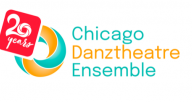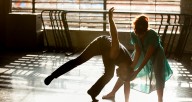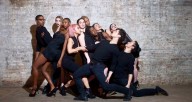Today’s artistic community has a plethora of political turmoil and social injustices to use as inspiration for all art mediums and platforms. Some choose to explore the plight of women through literary prowess while others delve into the deportation dangers many immigrants fear, but Chicago Danztheatre Ensemble is attempting to tackle several sociopolitical topics in their four-part performance series, “Art + Activism.” The second installment, “Stories of Chicago,” hits close to home as three incredibly different Windy City dance companies take a swing at addressing the systemic racism that plagues and shapes the city of Chicago.
The evening’s collection of works— ripe with dance, poetry, and an art gallery to boot— is showcased in the high-ceilinged, art-deco influenced auditorium of the Ebenezer Lutheran Church. It feels appropriate that such a divisive problem is being sermonized in such a location. The art gallery that surrounds the perimeter of the room helps propel the artsy ambience into a stratosphere entirely of its own, making it obvious Chicago Danztheatre Ensemble knows how to set the stage for the performance to come.
Dance Loop Chicago opened with their creation, “Enuf.” Three benches create an incomplete square at center stage, and in the tight performance space the company of ten enters with a strength only achieved by large numbers. The message behind “Enuf” clearly expresses a desire to resist and rage against systemic racism. Strong images, such as a man hanging from stacked up benches and fingers in the shape of guns, continue to reinforce the intention with a subtlety only appreciated in the fleeting seconds the dancers show them. The unison moments are captivating and entirely satisfying as they fortify the ideology fighting the problem together is more effective in getting our message across.
Given all that is strong about the piece, the music selection leaves something to be desired. With tracks like “Glory” by John Legend sprinkled throughout, the choices come across as obvious considering they’re so synonymous in popular culture with racial injustice and activism. Though they aren’t the wrong, the message may be better delivered if the piece were performed to a more individualized selection of music.
Following Dance Loop Chicago, Marcos Herrera performed obscure musings on race in America via his stylized poetic voice. Though he read straight from a packet of printed paper and his nerves showed at times when his voice cracked, the verbiage that fills his poetry coincided with the evening’s themed performance nicely. Herrera’s interlude paved the way for an excerpt of Re|Dance’s “The Biggest Wail From the Bottom of My Heart.”
In the 20 minutes it takes for the work to unfold, the company executes an impressive amount of movement. It’s clear Lucy Vurusic Riner’s company dances with one another as though it’s second nature, through her succinct unison choreography and their collectively invigorated performance quality. Her use of vocals and breath cues— something that can so easily be overdone— feels natural and well executed. The stage is so cleverly set to echo the stereotypical concept of the American dream, complete with a fake patch of green grass and a literal white picket fence. The acoustic and cheeky music selection hypes up the playful tone, yet the lyrics remind us there is a political bent to the movement. It isn’t until the last three minutes of the piece we’re able connect the movement with the topic of systemic racism in America, however the powerful chant with which Riner culminates the dance makes all the wondering worth it.
We’re offered a second poetic pause as Marcos Herrera executes yet another piece before the evening closes with South Chicago Dance Theatre’s “Dancing Beyond the Borderline: An Immersive Performance Experience.” The dance is simplistic in that there aren’t props like the works before it. Three women execute challenging choreography with immensely satisfying technique to an ambient speech about the concept of self. A man comes out and performs a solo with such personality it becomes impossible not to smile along with him. A sultry piece of jazz music plays as the four dancers move together in the tight space. The speech comes back into play, only this time it’s about how our family shapes the concept of self. It closes with each individual devouring packs of pink bubble gum in such copious amounts the scent of bubblegum fills the room. “Dancing Beyond the Borderline” is an intriguing work that highlights the South Chicago dancers perfectly, though it’s entirely unclear how this piece fit into the theme of Stories of Chicago.
Chicago Danztheatre Ensemble pieced together an evening of art that flowed from platform to platform seamlessly. Impressively, the hour long run time seems short given the amount of voices contributing to the activism-based performance. I found the theme of the performance wasn’t overtly apparent in the selected dances however, and this confused me give the marketing of the collective performance. The name “Stories of Chicago” led me to believe the companies would address Chicago’s racially related history, or even speak more to the political turmoil within our city.





